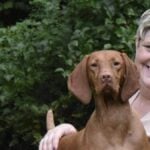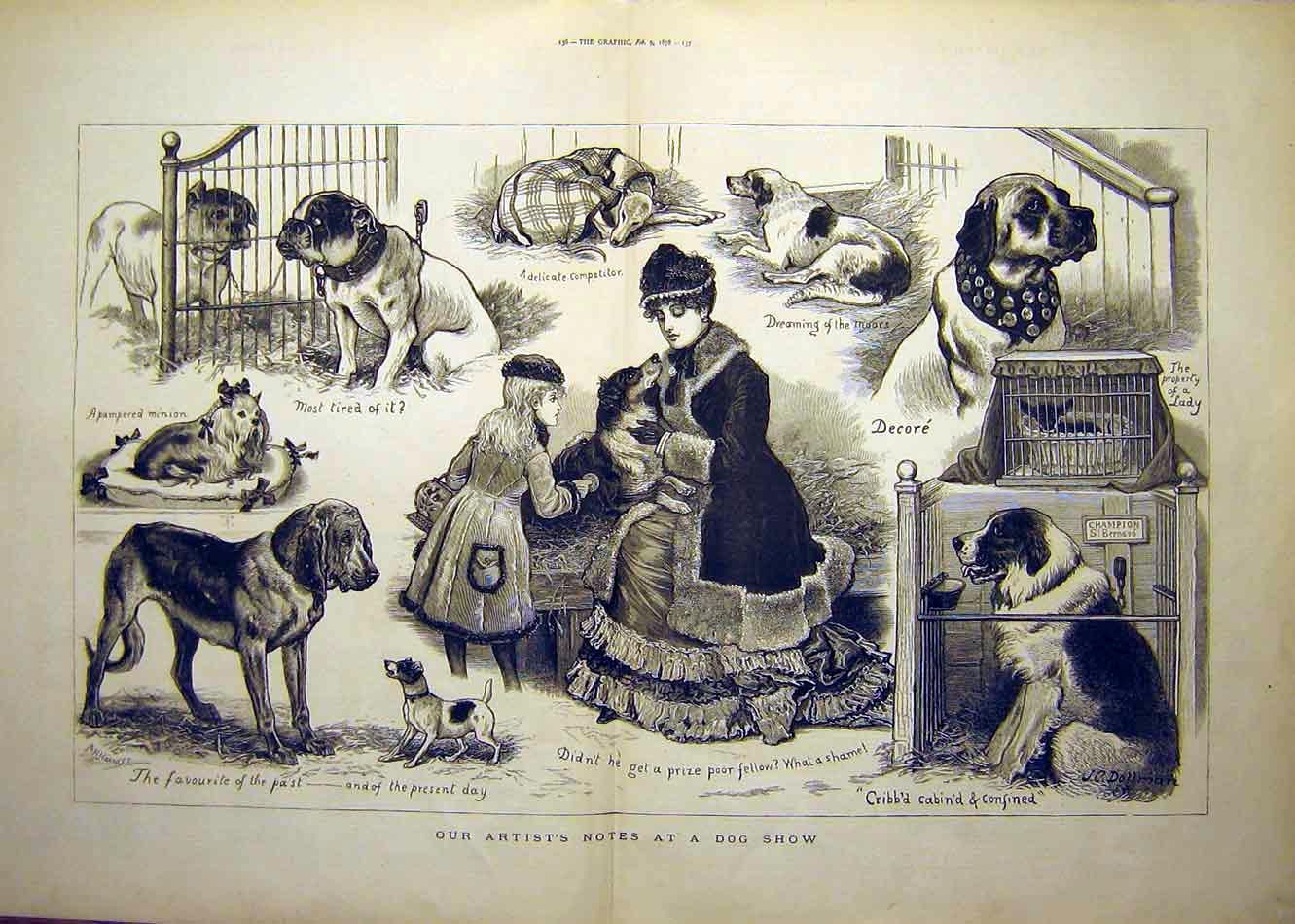
Home » The First Dog Show In America

The first officially recognized dog show in the world, according to this writer’s previous article entitled, The Origin of the Dog Show, took place in the New Cornmarket at Newcastle-upon-Tyne, in England, June 28-29, 1859.
That show was for Pointers and Setters only, and the Show Committee consisted of Mr. W. R. Pape, Mr. Tom Reed, and Mr. John Shorthose. Mr. William Arkwright, in his immortal classic, The Pointer and His Predecessors, quotes a letter he received from Mr. Pape; and in this letter, Mr. Pape says, “I got up the First Dog Show that was held in Newcastle, 1859.” Coming from that source, this information would safely enable us to label Mr. W. R. Pape as the “World’s First Bench Show Chairman.” Also, he must have been the “World’s First Trophy Chairman” because he gave all the trophies, which were guns from his own gun factory.
We now mount our research vantage point and take a panoramic view of the first four dog shows ever held in America. Dog shows had been flourishing in England and Europe for fifteen years before any attempt or suggestion was made with respect to putting on dog shows in this country. This can be explained, in part, by the fact that during most of these years, the majority of Americans were preparing for, engaging in, and recovering from the Civil War. When the war was finally terminated, it was not long before the silence, with reference to dog shows in the United States,
was broken.
P. H. BRYSON
FIRST ADVOCATE
Mr. P. H. Bryson of Memphis, Tennessee, the First Advocate of Dog Shows in America, was released after the Civil War ended and permitted to “go home to die so that he might have a decent burial.” This wounded, weak, and emaciated soldier weighed only 110 pounds, and could not walk 100 yards without stopping to rest. When he reached home, his family physician, Dr. D. D. Saunders, advised that he take all the outdoor exercise he could stand. Specifically, Dr. Saunders recommended a bird dog and a gun, stating that that sport would be an incentive to outdoor exercise. The weak, but courageous, soldier acquired a “pin-fire gun” and a “bobbed-tail Pointer” and took off for the rolling fields and the gurgling streams.
At first, Mr. Bryson could not walk far. However, his strength began to increase gradually. He killed one bird, then several birds, then a small bag of birds. In time, he weighed 210 pounds and had completely recovered his health.
As Mr. Bryson became a more avid sportsman, for some undisclosed reason, he switched from Pointers to Setters. He and his brother, David Bryson, imported some of the world’s finest Setter bloodlines. The “Bryson Setter Kennels” of Memphis, Tennessee, gained national recognition and acclaim. Then, the old soldier began to campaign for dog shows in America. Mr. Bryson was the first man in America to advocate, through sporting journals, the holding of dog shows in the United States. He did this through that highly respected sporting journal, Turf, Field and Farm. The Field Editor for this journal at that time was Colonel Frederic Gustavus Skinner. Colonel Skinner was an avid outdoorsman himself, and one of America’s greatest sporting editors. Consequently, he gave Mr. Bryson’s articles top billing in his magazine.
P.H. Bryson, his brother, David Bryson, and Mr. W. A. Wheatley planned a combined Bench Show and Field Trial near Memphis, Tennessee, for November of 1874. The articles that Mr. Bryson had been writing were so challenging and convincing that they motivated other sportsmen in other parts of the country to plan dog shows.
FIRST SHOW
JUNE 4, 1874
CHICAGO, ILLINOIS
The Illinois State Sportsmen’s Association, very obviously borrowing their idea from Mr. Bryson, announced a show for June 4, 1874. This was five months ahead of the show that P.H. Byson, his brother, and Mr. Wheatley had planned for Memphis, Tennessee. The Illinois show was for Setters and Pointers only; and since it was the first dog show of any kind ever staged in the United States, this writer feels it should have a rather full report. The report of this first dog show has been overlooked for too long and by too many able researchers and writers. Some have even stated that “no records were kept of the first show.” But fortunately, I, this writer, have found a more complete report of this show than we have of some of the subsequent shows. A magazine, then called Field and Stream, which this writer found on file in the American Kennel Club Library and in the New York City Library (both of which have complete files of this magazine), reported this show two days after it happened!
A word concerning the above mentioned magazine must be given here. On February 21, 1874, a sporting journal began publication in Chicago, Illinois, called Field and Stream. On March 27, 1875 the name of this magazine was changed to The Field. On June 3, 1880 the name was changed to Chicago Field. Then, on June 2, 1881, the name was changed to The American Field, and the journal has maintained that name to this day.
Field and Stream, in the June 6, 1874, issue carried a full report of that first dog show in the United States. It must be remembered here that at that time there was no American Kennel Club, no rules, no regulations, no breed standards, no precedents, and no program to follow. These men were blazing a new trail and here is their report:
DATE OF SHOW: JUNE 4, 1874
PLACE OF SHOW: CHICAGO, ILLINOIS
SHOW GIVING CLUB: ILLINOIS STATE SPORTSMAN ASSOCIATION
OFFICERS OF THE CLUB: John V. LeMoyne, Chicago, President; W. T. Johnson, Chicago, First Vice-President; John L. Pratt of Sycamore, Second Vice-President; Luther E. Shinn, Chicago, Secretary; C. B. Miller, Geneseo, Treasurer.
EXECUTIVECOMMITTEE: Abner Price, W. F. Milligan, C. W. Marsh, R. R. Clark, E. T. Martin.
JUDGES: Hon. L.B. Crocker of Meddota, Illinois; John Davidson of Monroe, Michigan; and H.N. Sherman of
Beloit, Wisconsin.
ENTRIES: Twenty-One Pointers and Setters
SHOW RESULTS:
Judges Report: “For style and action, cannot be too highly complimented, medium size and good appearance. Best
bitch exhibited.”
SECOND SHOW
JUNE 22, 1874
OSWEGO, NEW YORK
The New York State Sportsman Association planned a dog show to be held at Oswego, New York, June 22, 1874.
The report of this show was as follows:
“As there was no competition, there being but two dogs and one bitch entered, the committee deem it advisable to return the entrance money to the exhibitors, Mr. A. L. Sherwood and N. W. Nutting. The committee desires to express the highest commendation of Mr. Sherwood’s orange and white pair of Setters, and also of a beautiful litter of puppies, their progeny, ten points in form and breeding. Mr. Nutting’s black and tan Setter dog is a magnificent animal in all points but having a white spot on throat as well as upon the breast, he cannot be admitted as a
thorough-bred Gordon.”
THIRD SHOW
OCTOBER 7, 1874
MINEOLA, NEW YORK
The third Show was at Mineola, L. I., October 7, 1874. The show was judged by the English Kennel Club rules. The following were the awards:
IRISH SETTERS—DOGS: 1st, Duke, Hamilton Thompson, special premium cup; 2nd, Pilot, R. L. Lawrence, diploma. BITCHES: 1st, Lady, H. S. Parkes, special premium cup; 2nd, Fanny, R. W. Reid, diploma.
GORDON SETTERS—DOGS: 1st, Shot, T. A. Jerome, special premium cup; 2nd, Ponto, C. O. Doherty, diploma. BITCHES: 1st, Di, J.R. Tilley, special premium cup; 2nd, Kate, A. C. Waddell, diploma.
SETTERS OF ANY BREED—DOGS: 1st, Dash, A. C. Waddell, special premium cup; 2nd, Count, M. Leavitt, diploma. BITCHES: 1st, Maggie, Nelson, special premium cup; 2nd, Nelly, E. Orgill, diploma.
POINTERS—DOGS: 1st, Phil, A. C. Waddell, special premium cup; 2nd, Bang, J. Smith, diploma. BITCHES: 1st, Fanny, C. Porter, special premium cup; 2nd, Belle, A. C. Waddell, diploma.
FOURTH SHOW
OCTOBER 8, 1874
MEMPHIS, TENNESSEE
We now return to the home town of our old soldier, P. H. Bryson, where original plans were made for the first dog show in America. This was a combined Field Trial and Bench Show, sponsored by the Tennessee Sportsmen’s Association. The Show was governed by the English Kennel Club rules, and the Field Trial was conducted according to the rules of the English Field Trials. Since this was a combined Field Trial and Bench Show, present space will permit only the Best of Breed and Best in Show winners be given here. This writer will give this Show and Trial a complete report in a subsequent article, “The Origin of Field Trials.”
The Best of Breed and Best in Show judging at this Show reached an emotional pitch that probably has not been reached since at a dog show. When the judge was through sorting out the Pointers, he selected for Best of Breed a Pointer Bitch named “MAY,” owned by Dr. D. D. Saunders. When he was through examining the Setters, he selected for Best of Breed a Setter Bitch named “MAUD,” owned by P. H. Bryson.
Then came the big moment—the earth, seemingly, stopped moving and the spectators stopped breathing as the old soldier and his physician moved into the center of the ring to compete against each other for BEST IN SHOW. The solemn-faced judge stepped into the ring, fully conscious of his responsibility. Dr. Saunders and his Pointer moved about the ring as one. The old soldier and his Setter moved with the same military precision as if Generals Lee and Grant had been sitting at the ringside. After thoroughly examining both exhibits, the judge walked over to the Pointer, stopped, and ran his hands over the length of her back and down her thighs. He then turned to the Setter and did the same. Suspense mounted as the judge walked to the table to record his decision. In his book, he wrote, “Cup for best Setter or Pointer of any age or class of the Show, MAUD, P. H. Bryson.”
He then stepped back to the center of the ring with the cup in his hand and pointed to the old soldier and MAUD. Thunder sounded as the ringside exploded with cheers and shouts
of applause!